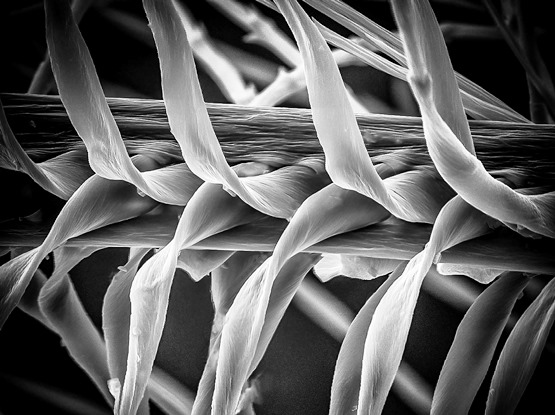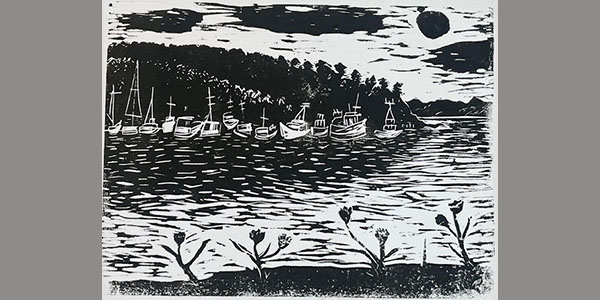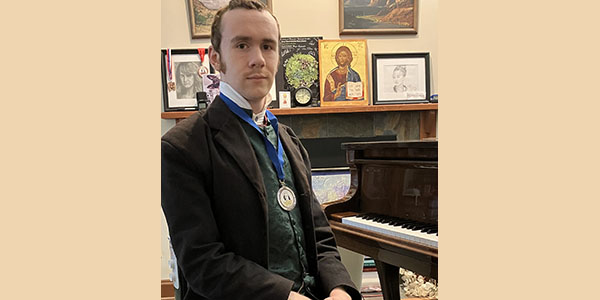— by Margie Doyle —

Gull feather interior from the downy section of the feather. Image copyright by Bob Dash. The scale of this micrograph is the width of 100 “spirals” on this gull feather would span the head of a pin.
Bob Dash, Orcas teacher, photographer and environmental artist, has been fascinated since childhood by microscopic life, feeling an “affinity for life’s beauty in small structures and a desire to share what I find.” His work portrays the “phenomenally small” elements of life, such as 400 pieces of pollen on the head of a pin.
Recently his work in exploring the intricacies of life with a scanning electronic microscope has gained national and international attention through publication in Time online magazine and the international photography website Lensculture.
As he probed deeper and deeper into the patterns of microscopic life, he sought a scanning electronic microscope to further his exploration. This kind of microscope takes a “micrograph,” without using light in the process; but instead scans electronically to create a resolution of the object. About a year ago he connected with the University of Washington Friday Harbor Labs’ and began using its microscope, viewing the micro-world of feathers, seeds, grass and leaves. “From that I started to see these remarkable structures,” says Dash, by which he describes cell stomata, the guard cells that allow carbon monoxide into an organism and release water and oxygen from it.
His micrographs drew the attention of a photographic editor for Time magazine science editor at a Portland, Ore. exhibition, and resulted in publicity for Dash in the article Time.com/see-incredible-close-ups-of-plant-life: “For billions of years these microscopic exhaust valves have helped keep oxygen and CO2 levels balanced in the atmosphere…..the micrographs of photographer Robert Dash reveal the stomata for the elegant—and fragile—things they are.”
He says that his work isn’t meant to advance the claim that plants respond to changing levels of carbon in the atmosphere, but that it is intended to show the beauty and fascination of micro-life. “While I’m fascinated by art and science combined, I try to be conservative, and rely on research that I’ve read and seen. It’s so important to artistically and culturally appreciate these things as we explore our love of the planet. That’s ecology and metaphor in one,” Dash says.
He describes his photography as the “metaphor of a guide or a naturalist taking someone for a walk.
“Nature and imagery are full of poetry, as one thing stands for another. Scientific and artistic love and curiosity are inseparable. I’m trying to explore that exchange through dialog and conversation. Artistic expression awakens memories and comparisons, in music, poetry, painting and dance — why not photography?
“All of us are trying to express what we love and care about, and we’re incredibly privileged if anybody cares to hear. I don’t want to do my work in a vacuum, I like to share through imagery; I want to converse about it. To bring the world into the combination is a sweet opportunity.”
Dash says he spends all his free time exploring and sharing the micro-world. “For me it’s total fun, pleasure.
“Micro landscapes especially intrigue me; they suggest layers within layers, which is how I experience the world. It awakens my fascination and imagination.The following quote speaks to one of those layers—why pursue this art in the first place?”
“In a sense, all of us — even the most untechnological, spiritual, and benign peoples — are constantly wrecking the world. The question is: how do we respond to that destruction? If we respond as we do in modern culture, by ignoring the spiritual debt that we create just by living, then that debt will come back to bite us, hard. But there are other ways to respond. One is to try to repay that debt by giving gifts of beauty and praise to the sacred, to the invisible world that gives us life.” Martin Prechtel, Sun Magazine Interview, 2001.
Dash is now working on the forthcoming book, An Acre Shy of Eternity: Ecology and Metaphor on One Seaside Cliff about “the land where I live and all the layers of beauty that happen in plant life and the water.” He teaches at OASIS High School and is a board member of “Orcas Currents.”
Also, Dash is on the Islands Museum of Art Artists’ Registry and his work will be part of the Olga Artworks starting in February, 2016.
See more of Robert Dash’s work on his website https://www.robertdashphotography.com/
**If you are reading theOrcasonian for free, thank your fellow islanders. If you would like to support theOrcasonian CLICK HERE to set your modestly-priced, voluntary subscription. Otherwise, no worries; we’re happy to share with you.**








Enchantingly and distractingly beautiful images. Thank you, Bob!
Such beautiful words and rich meanings, Bob! The photo is mesmerizing.